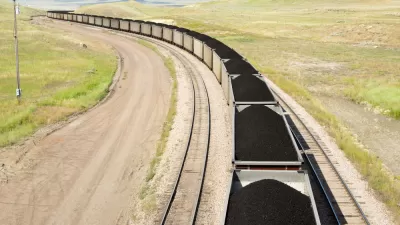The state of Wyoming made billions in tax revenues off the coal industry. But after waves of layoffs, those left in the state are asking: What's left of those revenues for workers?
Dustin Bleizeffer reports on the human toll of the coal industry's collapse in Wyoming, where the state made billions off the coal industry, but now has thousands of recently laid off workers in need of help. Bleizeffer provides the backstory:
For 40 years, Gillette, Campbell County and all of Wyoming have feasted on revenues from mining coal — spending billions of dollars on roads, pipelines, schools and other public facilities, and socking away billions in savings. The corpus of Wyoming’s Permanent Mineral Trust Fund stands at more than $7 billion (bolstered mostly by coal, oil and natural gas). The Wyoming State Treasurer’s Office says it invests a total $19 billion.
Growing ranks of unemployed are lamenting the loss of high-paying jobs (Wyoming coal miners, on average, gross $82,000) and wondering if they will have to move away from towns built with excellent public facilities, financed by coal industry revenues. The article concludes by explaining the details, such as they are, of the state's response to the coal industry layoffs.
FULL STORY: Laid off coal miners on their own after fueling Wyo economy for decades

Alabama: Trump Terminates Settlements for Black Communities Harmed By Raw Sewage
Trump deemed the landmark civil rights agreement “illegal DEI and environmental justice policy.”

Planetizen Federal Action Tracker
A weekly monitor of how Trump’s orders and actions are impacting planners and planning in America.

The 120 Year Old Tiny Home Villages That Sheltered San Francisco’s Earthquake Refugees
More than a century ago, San Francisco mobilized to house thousands of residents displaced by the 1906 earthquake. Could their strategy offer a model for the present?

In Both Crashes and Crime, Public Transportation is Far Safer than Driving
Contrary to popular assumptions, public transportation has far lower crash and crime rates than automobile travel. For safer communities, improve and encourage transit travel.

Report: Zoning Reforms Should Complement Nashville’s Ambitious Transit Plan
Without reform, restrictive zoning codes will limit the impact of the city’s planned transit expansion and could exclude some of the residents who depend on transit the most.

Judge Orders Release of Frozen IRA, IIJA Funding
The decision is a victory for environmental groups who charged that freezing funds for critical infrastructure and disaster response programs caused “real and irreparable harm” to communities.
Urban Design for Planners 1: Software Tools
This six-course series explores essential urban design concepts using open source software and equips planners with the tools they need to participate fully in the urban design process.
Planning for Universal Design
Learn the tools for implementing Universal Design in planning regulations.
Clanton & Associates, Inc.
Jessamine County Fiscal Court
Institute for Housing and Urban Development Studies (IHS)
City of Grandview
Harvard GSD Executive Education
Toledo-Lucas County Plan Commissions
Salt Lake City
NYU Wagner Graduate School of Public Service



























